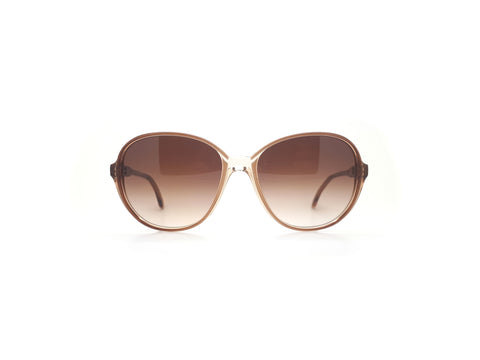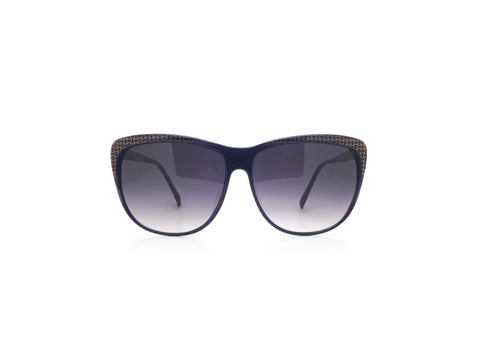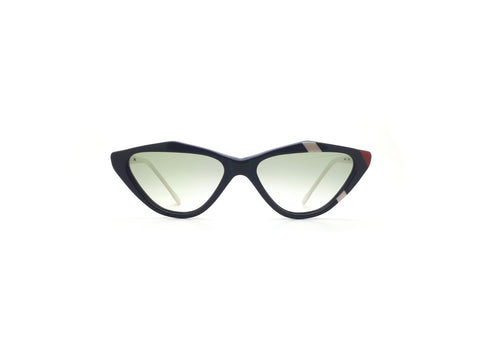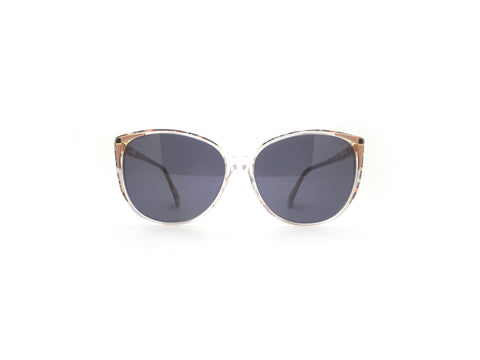The who, what, why and where of sunglasses
Timeline
| 200+ BC | Inuit natives of Northern America design frames to reduce sun-glare. |
| 13th century | The Chinese courtesans use a tinted quartz lens. |
| 16th century | The adoption of sunglasses is taken up by the richest in society. |
| 18th century | Gondoliers take to wearing the Goldini frame. |
| 19th century | The prevalence of syphilis makes sunglasses a must amongst the promiscuous. |
| Early 20th century | The first mass-produced brands launch and design innovations occur as a result of war and transport boom. |
| Late 20th century | An explosion of styles is created from the new materials available to designers. |
NECESSITY THE MOTHER OF INNOVATION
Sunny's eye prize open and he dusts away the small globules of sleep that have formed over the short night, he gently lifts the heavy fur off himself to venture out of the tent. His throat burns for a second as he is quenched by the first trickles of icy water. Yesterday's barren hunt was weighing heavy on his weary frame and yet as he snacked upon his meagre breakfast there was, he felt, optimism in the biting air. The dogs were startled as Sunny approached, leaning in to seal the harness of the lead sleigh dog he spoke softly into its ear.
"Don't be scared, it's just me. I'm wearing my new invention, I call them sunglasses, what do you think?"
Ok so I may have taken a poetic license a little with the name Sunny but the fact remains that any history of sunglasses has to start in the far Arctic North. The incredible glare of the sun against the tundra forced the Inuit people into creating a hunting tool to allow them to be outside during the long Summer days without suffering from snow blindness. Often carved from walrus ivory or wood they were designed with very slight slits that would allow only minimal amounts of light through to the eye. Whilst they win few prizes for style they have subsequently in scientific studies been shown to be very effective at fighting snow blindness.

IT WASN'T ALL SPICES ON THE SILK ROAD
The roots of modern lensed sunglasses can be traced back to the courtesans of ancient China around the 1200s and perhaps earlier. Documents have been found which make a reference to "Ai Tai" which translates to "dark clouds covering the sun". Sheets of smoked quartz were used as an aid to vision in scenarios where the sun was an issue but there are also clear references to these shades being used for anonymity for the first time. Judges were found to have used the smoked quartz to conceal their thoughts and facial expressions during trials, so it wasn't the poker players who were the first to wear their sunglasses indoors.
As the technology moved across to Europe via the silk road trading routes sunglasses were not an immediate must-have status symbol that they are today. One of the ultimate slow burner trends it took a few centuries for the wealthy elites of Europe to start getting their hypebeast on.

So what was the first ever highly anticipated sunglasses drop ever? The Carlo Goldini's of course, so called after one of the top playwrights of the day they found a home on the faces of Venice's most discerning gondoliers whose profession meant that they had to spend long hours in the blazing Venetian sun.
GONDOLIERS TO GONORRHEA!
From the canals of Venice, our history tour now starts to get a little steamy. The chatting classes and socialites across Europe were infamous for their hedonistic, bohemian lifestyles. However, our forefathers and mothers in the liberal movement were sadly lacking in some of the basic tools to live such a lifestyle in a healthy and safe manner. With antibiotics yet to be discovered and condoms literally made from leather, it is no surprise that STDs flourished across the population and one of the most prevalent of these undesirable afflictions was syphilis. A major side effect of which if left untreated is an acute sensitivity to light, and so it came to be that the monied-up classes started to sport sunglasses. Contrary to these sufferers being outcasts the wearing of sunglasses become a status symbol of sorts, defining one as a decadent playboy or playgirl, how times have changed!
LIFE AND DEATH
The outbreak of war across Europe created a totally different customer base and also drove forward advances in technology. The large orders required by countries war departments led to the start of large-scale mass production of sunglasses. The use of aircraft in World War I had been a game changer on the battlefields and Giuseppe Ratti, an Italian optician based in Turin, met with returning pilots who would explain to him the difficulties of flying with sun-glare. High-quality sunglasses were now literally the difference between life and death and it is out of this backdrop that Persol was born. Moreover, this period had massive advances in the fields of motor vehicles which further increased the market of potential customers for functional sun protection.

TIME FOR GLAMOUR
Across the pond, we have our American cousins to thank for the promotion of fashionable sunglasses as in 1919 Foster Grant (Yep that rather sad brand with racks of sunglasses in service stations off the M11) launched. Sam Foster got his timing just right and as the roaring twenties began to take full swing Hollywood was ballooning into a cultural phenomenon. Not only did writers start to write in characters who would wear sunglasses but these new celebrities like Charlie Chaplin and Jean Harlow wore them in an attempt to preserve some anonymity. It didn't work too well however as they were papped in their Foster Grant frames and sales started to fly in from men and women who wanted to emulate their idols on the silver screen. This trend has since only snowballed and spawned a whole new industry in itself in the form of product placement.

BLUE SKY THINKING
Once again in the late 1930s, it was the issue of high altitude glare that led to the design of perhaps the most iconic sunglasses frame of all. When Bausch and Lomb optical company were commissioned by the US Airforce to produce a new frame for their airborne troops they couldn't have known the enduring design would still be around today. The aviator frame was combined with polarised lenses to improve the clarity of vision for pilots. It is off the back of this design that Ray-Ban was created. Their release to the general public coincided with the US troops returning from the Second World War and these daring heroes were the perfect poster boys for this frame, men wanted to be them and women wanted to be with them, the aviator instantly became the coolest sunglasses frame on the block.

NOW FOR THE SPORTS
The other slightly more fun activity that has played a huge role in the design and technology in fashion sunglasses are outdoor pursuits. Brands like Carrera and Vuarnet were launched to offer protection for the burgeoning upper-middle-class holidaymakers who were starting to holiday in the Rockies and the Italian and French Alps. An important factor in the design of these shades was that they had to perform not only on the steepest of slopes but also when relaxing at the bars and restaurants around the villages of Verbier, Chamonix and Aspen. The sporting arena also led to the growth of Oakley who focussed initially on motorsports but gradually became the brand of choice for any extreme sports enthusiast from mountain bikers to climbers, surfers and beyond.

AN EXPLOSION OF STYLE
Wilhelm Anger the founder of Carrera can also be attributed with one of the key evolutions of fashion sunglasses, the development of Optyl. Optyl allowed for a massive range of plastic frames to be designed in larger and more outlandish styles. 20% lighter than traditional acetates and easily heated to fit perfectly as well as it's hypoallergenic qualities made this material a godsend to eyewear designers.
As fun new styles started to enter the market and with sunglasses growing in popularity around the world big brands started to sit up and take notice. It was Christian Dior who was the first of the major fashion houses to throw their hat in the ring. Their success over the 1960s led to any top designer worth their salt getting involved and this amalgamation of haute couture fashion and functionality is what gives vintage sunglasses produced during this era their enduring fan base. Often made in factories across mainland Europe and the US as well as Japan in the late 80s the high levels of hand finishing required meant that so many new old stock vintage sunglasses are in such great condition today. Persol frames for example required over 20 hand-checked steps during the production of each frame.
It was also during the late 80s that licensing model started to become ubiquitous in the fashion industry. Guaranteeing fashion houses regular profits and sizeable royalty cheques companies such as Safilo, Luxoticca and Carrera Optyl competed with one another for contracts to manufacture frames for all the biggest fashion brands. Today the sunglasses industry is now a multi-billion dollar business and almost everyone in the world owns a pair of sunglasses or two, I wonder if Sunny knew what he was starting on that cold morning.




